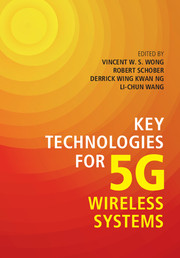Book contents
- Frontmatter
- Contents
- List of Contributors
- Preface
- 1 Overview of New Technologies for 5G Systems
- Part I Communication Network Architectures for 5G Systems
- Part II Physical Layer Communication Techniques
- 6 Non-Orthogonal Multiple Access (NOMA) for 5G Systems
- 7 Flexible Physical Layer Design
- 8 Distributed Massive MIMO in Cellular Networks
- 9 Full-Duplex Protocol Design for 5G Networks
- 10 Millimeter Wave Communications for 5G Networks
- 11 Interference Mitigation Techniques for Wireless Networks
- 12 Physical Layer Caching with Limited Backhaul in 5G Systems
- 13 Cost-Aware Cellular Networks Powered by Smart Grids and Energy Harvesting
- 14 Visible Light Communication in 5G
- Part III Network Protocols, Algorithms, and Design
- Index
- References
7 - Flexible Physical Layer Design
from Part II - Physical Layer Communication Techniques
Published online by Cambridge University Press: 28 April 2017
- Frontmatter
- Contents
- List of Contributors
- Preface
- 1 Overview of New Technologies for 5G Systems
- Part I Communication Network Architectures for 5G Systems
- Part II Physical Layer Communication Techniques
- 6 Non-Orthogonal Multiple Access (NOMA) for 5G Systems
- 7 Flexible Physical Layer Design
- 8 Distributed Massive MIMO in Cellular Networks
- 9 Full-Duplex Protocol Design for 5G Networks
- 10 Millimeter Wave Communications for 5G Networks
- 11 Interference Mitigation Techniques for Wireless Networks
- 12 Physical Layer Caching with Limited Backhaul in 5G Systems
- 13 Cost-Aware Cellular Networks Powered by Smart Grids and Energy Harvesting
- 14 Visible Light Communication in 5G
- Part III Network Protocols, Algorithms, and Design
- Index
- References
Summary
Introduction
The role of software in mobile communication systems has increased over time. For the upcoming fifth generation (5G) mobile networks, the concept of software-defined networking (SDN) can ease network management by enabling anything as a service. Software-defined radio (SDR) enables radio virtualization, where several radio components are implemented in software. Cognitive radio (CR) goes one step further by using a software-based decision cycle to self-adapt the SDR parameters and consequently optimize the use of communication resources. This proposal leads to the possibility of having real-time communication functionalities at virtual machines in cloud computing data centers, instead of deploying specialized hardware. Network functions virtualization (NFV) claims to provide cloud-based virtualization of network functionalities. The perspective is that all these software-based concepts should converge while 5G networks are being designed. A new breakthrough will be achieved when all these software paradigms are applied to the physical layer (PHY), where its functionalities are defined and controlled by software as well.
A flexible PHY design is particularly beneficial considering the diverse applications proposed for 5G [1]. In fact, these applications typically have conflicting design objectives and face extreme requirements. Broadband communication will play an important role in, for instance, offering video streaming services with high resolution for TV and supporting high-density multimedia such as 4K and 3D videos in smartphones. Data rates up to 10 gigabits per second (Gbps) are therefore being targeted in 5G. The Tactile Internet [2] enables one to control virtual or real objects via wireless links with haptic feedback. This implies that the end-to-end latency constraint in 5G must be dropped by at least one order of magnitude compared with current fourth generation (4G) technologies. The Internet of Things (IoT) is aimed at connecting a massive amount of devices. Wireless sensor networks need to provide in-service monitoring at low cost and with a long battery life. Smart vehicles improve safety and actively avoid accidents by exchanging their driving status, such as position, breaking, acceleration, and speed, with surrounding vehicles and infrastructure via challenging doubly dispersive channels. Overall, this demands asynchronous multiple access, ultra-low latency, and ultra-high reliability.
Information
- Type
- Chapter
- Information
- Key Technologies for 5G Wireless Systems , pp. 133 - 150Publisher: Cambridge University PressPrint publication year: 2017
